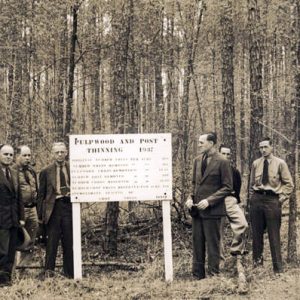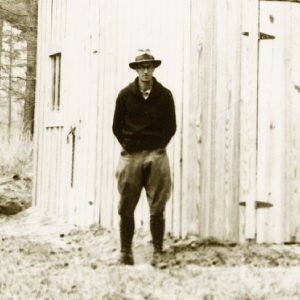calsfoundation@cals.org
Crossett Experimental Forest (CEF)
Established in 1934, the Crossett Experimental Forest (CEF) of the United States Department of Agriculture (USDA) Forest Service was one of the first experimental forests in the southern United States. It has provided decades of scientific research on topics ranging from forest ecology and silviculture to wildlife, hydrology, and soils in the loblolly and shortleaf pine-dominated forests of the Upper West Gulf Coastal Plain geographic province. The scores of studies conducted on the CEF have generated hundreds of scientific publications, making the station an internationally known example of high-quality long-term forestry research. Long-term research studies and demonstration projects also serve as in-the-woods educational opportunities regarding low-cost forestry practices, and tens of thousands of students, professionals, and others have visited the CEF over the years to learn about southern pine silviculture.
The history of the CEF began with a single company. Large-scale lumbering in Ashley County followed the 1899 incorporation of the Crossett Lumber Company (CLC). By 1902, a growing CLC consumed incredible quantities of pine and hardwood. Lumbering continued unabated well into the 1920s, when it became obvious that the virgin timber was running out. The CLC was facing the choice of either changing its practices and engaging in sustainable forestry or going out of business. However, even with the help of Yale University professor Herman Haupt Chapman and the efforts of company foresters, too little was known about the silviculture of loblolly and shortleaf pine forests to manage the lands effectively.
To address this lack of information, the CLC began working with the Southern Forest Experiment Station of the USDA Forest Service. In July 1930, the experiment station hired Russell R. Reynolds, a recent University of Michigan forestry graduate, to conduct inventories and help landowners develop sustainable forestry plans. Two years later, Reynolds and the experiment station assisted the Ozark-Badger Lumber Company of Wilmar (Drew County), and Reynolds became familiar with the CLC. Around this time, Albert E. Wackerman, one of the first CLC foresters, came to work for the experiment station. Both the CLC and the experiment station recognized the opportunity for Reynolds and Wackerman to help manage the CLC’s timberland, including their last 25,000 acres of virgin pine.
Reynolds moved to Crossett (Ashley County) in August 1933 and immediately began work with a local Civilian Conservation Corps (CCC) crew inventorying and marking timber for the CLC. Reynolds also supervised studies of partial harvests of southern pines and the use of trucks in logging. As valuable as these initial studies were, an experimental forest was also needed for properly controlled long-term research. In the fall of 1933, Reynolds and Wackerman searched for a suitable location on the CLC’s cutover land. Approximately seven miles south of Crossett, the boundary of the new Crossett Experimental Forest was laid out in October 1933. This 1,680-acre parcel had been cut before 1920 by loggers from the Hickory Grove Camp of the CLC. The CLC agreed to a long-term arrangement with the experiment station that gave the Forest Service the land in exchange for the standing volume of the timber and a promise to conduct research continually on the site for the next fifty years. A warranty deed finally conveyed the property to the government on August 2, 1934.
Work on the CEF facilities began in late 1933 with help from civilian relief programs. A Civilian Work Project to build roads on the CEF was granted by the Federal Emergency Relief Administration on December 16, 1933, and construction started immediately. By September 1934, workers were building structures to lodge the CCC inventory crew, and sites for a house, filling station, and garage were established. Construction of these buildings began in September 1935 under a new relief program, the Works Progress Administration (WPA). Along with other buildings, a log cabin–style home for Reynolds and his family was finished enough to permit occupancy on July 9, 1936; this remained their home for the next thirty-three years. Most of the structures were completed by the end of 1936. Several other buildings were later added with CCC labor, including three now listed on the National Register of Historic Places—a garage-type log building constructed in 1939 by the 768th Company of the Arkansas CCC, as well as a storage building and small residence adjacent to the main office, both finished in 1940.
The primary objective of Reynolds and his staff at the CEF was to develop silvicultural principles and practices to manage the cutover second-growth loblolly-shortleaf pine-hardwood stands typical of the area. The challenge was whether it was possible to rehabilitate existing stands while simultaneously providing landowners with an acceptable return on their investment. If so, CEF research had considerable practical application not just for the CLC but also for other companies and landowners across the southern United States.
One of the reasons the experiment station was given the CEF was because of troubles the CLC had with arson. Hence, fire prevention became an important goal. To help implement fire control and the establishment of large-scale research and demonstration projects, Reynolds divided the CEF into twenty-four contiguous forty-acre blocks. Firelines between the blocks were hand-built by WPA crews, and these lines have been maintained to this day. To help gauge the success of the rehabilitation effort, Reynolds established a program to monitor stand structure and growth, and to harvest each block. For instance, in the fall of 1936, Reynolds initiated a detailed study on two of the blocks to represent forestry practices that farmers could imitate on their own woodlots. Called the “Farm Forestry Forty Study,” these blocks were managed using light partial cuttings to produce a sustainable, uneven-aged stand of pine timber. Seventy years later, these Farm Forestry demonstrations still exist, along with other long-term research and demonstration projects.
Reynolds and other experiment station scientists were stationed at the CEF for many years. Reynolds retired in 1969, and work continued. However, budget cuts in the Forest Service prompted the experiment station to close the CEF (with the intention of the closure being permanent) on August 9, 1974, after serving Crossett and the nation for forty years. Shortly thereafter, it became clear that the CEF would revert back to the original landowner (now the Georgia-Pacific Corporation) without an active research program. Even though the Forest Service had tried to close the CEF just a few years earlier, the imminent loss of the assets, including the historic buildings and the irreplaceable long-term demonstrations and studies, came to the attention of Forest Service chief John McGuire, who decided to reestablish the research unit. The newly rededicated CEF opened with considerable fanfare on February 14, 1979, with addresses by Forest Service deputy chief of research Robert E. Buckman and U.S. senator Dale L. Bumpers. Although no scientists are currently stationed there, the CEF maintains an active program of forestry research and demonstration to this day.
For additional information:
Baker, James B., and Larry M. Bishop. Crossett Demonstration Forest Guide. General Report R8-GR 6. New Orleans: USDA Forest Service, Southern Forest Experiment Station, 1986.
Bragg, Don C. “The Founding Fathers of the Crossett Experimental Forest.” Forest History Today 18 (Fall 2012): 40–44.
———. “History on the Road: A Mapped History of the Crossett Experimental Forest.” Forest History Today 18 (Fall 2012): 45–53.
“Forest Service closes Crossett operation after 39 years.” The News Observer. August 15, 1971, p. 1A.
“Forestry ‘began in Crossett,’ Bumpers says in dedicating reactivated experiment center.” The News Observer. February 28, 1979, p. 1B.
Reynolds, Russell R. The Crossett Story: The Beginnings of Forestry in Southern Arkansas and Northern Louisiana. General Technical Report SO-32. New Orleans: USDA Forest Service, Southern Forest Experiment Station, 1980.
Don C. Bragg and James M. Guldin
USDA Forest Service
Southern Research Station
 Crossett Experimental Forest
Crossett Experimental Forest  Crossett Experimental Forest
Crossett Experimental Forest  Russell Reynolds, Crossett Experimental Forest
Russell Reynolds, Crossett Experimental Forest  Crossett Research
Crossett Research 




Comments
No comments on this entry yet.